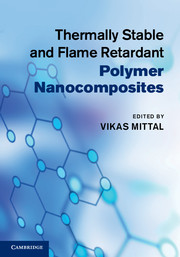Book contents
- Frontmatter
- Contents
- Contributors
- Preface
- Part I Thermal stability
- 1 Polymer nanocomposites
- 2 Mechanism of thermal degradation of layered silicates modified with ammonium and other thermally stable salts
- 3 Thermal stability of polystyrene nanocomposites from improved thermally stable organoclays
- 4 Poly(ethylene terephthalate) nanocomposites using nanoclays modified with thermally stable surfactants
- 5 Thermally stable polyimide/4,4′-bis(4-aminophenoxy)phenylsulfone-modified clay nanocomposites
- 6 Clays modified with thermally stable ionic liquids with applications in polyolefin and polylactic acid nanocomposites
- Part II Flame retardancy
- Index
- References
1 - Polymer nanocomposites
Layered silicates, surface modifications, and thermal stability
from Part I - Thermal stability
Published online by Cambridge University Press: 05 August 2011
- Frontmatter
- Contents
- Contributors
- Preface
- Part I Thermal stability
- 1 Polymer nanocomposites
- 2 Mechanism of thermal degradation of layered silicates modified with ammonium and other thermally stable salts
- 3 Thermal stability of polystyrene nanocomposites from improved thermally stable organoclays
- 4 Poly(ethylene terephthalate) nanocomposites using nanoclays modified with thermally stable surfactants
- 5 Thermally stable polyimide/4,4′-bis(4-aminophenoxy)phenylsulfone-modified clay nanocomposites
- 6 Clays modified with thermally stable ionic liquids with applications in polyolefin and polylactic acid nanocomposites
- Part II Flame retardancy
- Index
- References
Summary
Introduction
Inorganic fillers have conventionally been added to polymer matrices to enhance their mechanical strength and other properties, as well as to reduce the cost of the overall composites. Layered aluminosilicates, also popularly described as clays, are one such type of filler, which are responsible for a revolutionary change in polymer composite synthesis as well as for transforming polymer composites into polymer nanocomposites. Aluminosilicate particles consist of stacks of 1 nm–thick aluminosilicate layers (or platelets) in which a central octahedral aluminum sheet is fused between two tetrahedral silicon sheets. Owing to isomorphic substitutions, there is a net negative charge on the surface of the platelets that is compensated for by the adsorption of alkali or alkaline earth metal cations. Because of the presence of alkali or alkaline earth metal cations on their surfaces, the platelets are electrostatically bound to each other, causing an interlayer to form in between. The majority of the cations are present in the interlayers bound to the surfaces of the platelets, but a small number of cations are bound to the edges of the platelets. Though the use of layered aluminosilicates has been documented in some older studies, indicating their potential for substantially improving polymer properties, reports from Toyota researchers in the early nineties attracted serious attention. In these studies, polyamide nanocomposites were synthesized by in situ polymerization in the presence of clay with organic modifiers.
- Type
- Chapter
- Information
- Publisher: Cambridge University PressPrint publication year: 2011
References
- 1
- Cited by

